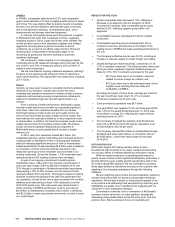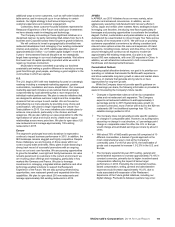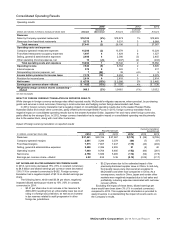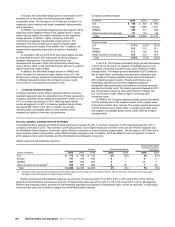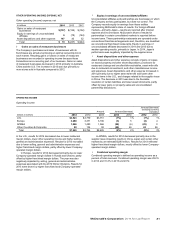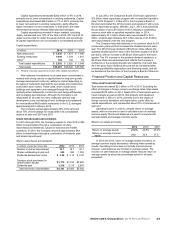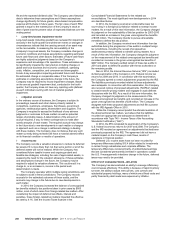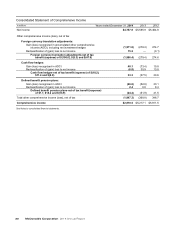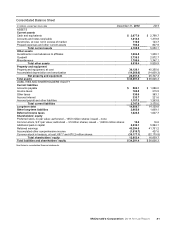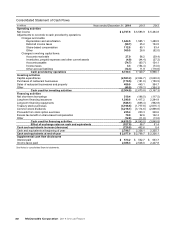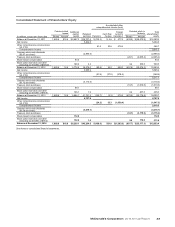McDonalds 2014 Annual Report Download - page 30
Download and view the complete annual report
Please find page 30 of the 2014 McDonalds annual report below. You can navigate through the pages in the report by either clicking on the pages listed below, or by using the keyword search tool below to find specific information within the annual report.
24 McDonald’s Corporation 2014 Annual Report
FINANCING AND MARKET RISK
The Company generally borrows on a long-term basis and is
exposed to the impact of interest rate changes and foreign
currency fluctuations. Debt obligations at December 31, 2014
totaled $15.0 billion, compared with $14.1 billion at December 31,
2013. The net increase in 2014 was primarily due to net issuances
of $1.5 billion partly offset by changes in exchange rates on
foreign currency denominated debt of $663 million.
Debt highlights(1)
2014 2013 2012
Fixed-rate debt as a percent of total
debt(2,3) 74% 74% 74%
Weighted-average annual interest
rate of total debt(3) 4.0 4.0 4.0
Foreign currency-denominated debt
as a percent of total debt(2) 40 41 36
Total debt as a percent of total
capitalization (total debt and total
Shareholders' equity)(2) 54 47 47
Cash provided by operations as a
percent of total debt(2) 45 50 51
(1) All percentages are as of December 31, except for the weighted-average
annual interest rate, which is for the year.
(2) Based on debt obligations before the effect of fair value hedging
adjustments. This effect is excluded as these adjustments have no impact
on the obligation at maturity. See Debt financing note to the consolidated
financial statements.
(3) Includes the effect of interest rate swaps.
Fitch, Standard & Poor’s and Moody’s currently rate, with a
stable outlook, the Company’s commercial paper F1, A-1 and P-1,
respectively; and its long-term debt A, A and A2, respectively.
Certain of the Company’s debt obligations contain cross-
acceleration provisions and restrictions on Company and
subsidiary mortgages and the long-term debt of certain
subsidiaries. There are no provisions in the Company’s debt
obligations that would accelerate repayment of debt as a result of
a change in credit ratings or a material adverse change in the
Company’s business. Under existing authorization from the
Company’s Board of Directors, at December 31, 2014, the
Company had $4.5 billion of authority remaining to borrow funds,
including through (i) public or private offering of debt securities;
(ii) direct borrowing from banks or other financial institutions; and
(iii) other forms of indebtedness. In addition to debt securities
available through a medium-term notes program registered with
the U.S. Securities and Exchange Commission ("SEC") and a
Global Medium-Term Notes program, the Company has
$2.5 billion available under a committed line of credit agreement
as well as authority to issue commercial paper in the U.S. and
global markets (see Debt Financing note to the consolidated
financial statements). Debt maturing in 2015 is approximately
$1.1 billion of long-term corporate debt. In 2015, the Company
expects to issue commercial paper and long-term debt to
refinance this maturing debt. As of December 31, 2014, the
Company's subsidiaries also had $863 million of borrowings
outstanding, primarily under uncommitted foreign currency line of
credit agreements.
The Company uses major capital markets, bank financings
and derivatives to meet its financing requirements and reduce
interest expense. The Company manages its debt portfolio in
response to changes in interest rates and foreign currency rates
by periodically retiring, redeeming and repurchasing debt,
terminating swaps and using derivatives. The Company does not
hold or issue derivatives for trading purposes. All swaps are over-
the-counter instruments.
In managing the impact of interest rate changes and foreign
currency fluctuations, the Company uses interest rate swaps and
finances in the currencies in which assets are denominated. The
Company uses foreign currency debt and derivatives to hedge the
foreign currency risk associated with certain royalties,
intercompany financings and long-term investments in foreign
subsidiaries and affiliates. This reduces the impact of fluctuating
foreign currencies on cash flows and shareholders’ equity. Total
foreign currency-denominated debt was $5.9 billion and
$5.8 billion for the years ended December 31, 2014 and 2013,
respectively. In addition, where practical, the Company’s
restaurants purchase goods and services in local currencies
resulting in natural hedges. See the Summary of significant
accounting policies note to the consolidated financial statements
related to financial instruments and hedging activities for additional
information regarding the accounting impact and use of
derivatives.
The Company does not have significant exposure to any
individual counterparty and has master agreements that contain
netting arrangements. Certain of these agreements also require
each party to post collateral if credit ratings fall below, or
aggregate exposures exceed, certain contractual limits. At
December 31, 2014, neither the Company nor its counterparties
were required to post collateral on any derivative position, other
than on hedges of certain of the Company’s supplemental benefit
plan liabilities where our counterparty was required to post
collateral on its liability position.
The Company’s net asset exposure is diversified among a
broad basket of currencies. The Company’s largest net asset
exposures (defined as foreign currency assets less foreign
currency liabilities) at year end were as follows:
Foreign currency net asset exposures
In millions of U.S. Dollars 2014 2013
Euro $ 4,949 $ 7,302
Australian Dollars 2,038 1,933
British Pounds Sterling 1,460 1,479
Canadian Dollars 1,231 1,412
Japanese Yen 640 390
The Company prepared sensitivity analyses of its financial
instruments to determine the impact of hypothetical changes in
interest rates and foreign currency exchange rates on the
Company’s results of operations, cash flows and the fair value of
its financial instruments. The interest rate analysis assumed a one
percentage point adverse change in interest rates on all financial
instruments, but did not consider the effects of the reduced level of
economic activity that could exist in such an environment. The
foreign currency rate analysis assumed that each foreign currency
rate would change by 10% in the same direction relative to the
U.S. Dollar on all financial instruments; however, the analysis did
not include the potential impact on revenues, local currency prices
or the effect of fluctuating currencies on the Company’s
anticipated foreign currency royalties and other payments received
from the markets. Based on the results of these analyses of the
Company’s financial instruments, neither a one percentage point
adverse change in interest rates from 2014 levels nor a 10%
adverse change in foreign currency rates from 2014 levels would
materially affect the Company’s results of operations, cash flows
or the fair value of its financial instruments.
LIQUIDITY
The Company has significant operations outside the U.S. where
we earn over 60% of our operating income. A significant portion of
these historical earnings are considered to be indefinitely
reinvested in foreign jurisdictions where the Company has made,


